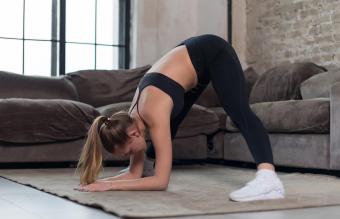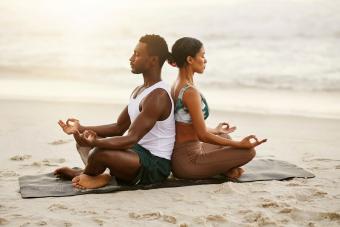
Yoga is like a stool with three legs: asanas, or physical postures; meditation, or stilling the mind; and pranayama, or conscious breath control. All three are necessary for stability, and breathing exercises are the connective tissue that deepens mastery of the other two. You can devote a separate portion of each yoga session to pranayama, or you can incorporate controlled breathing into the practice of the physical postures.
Mastering Breathing
Pandit Rajmani Tigunait, the spiritual head of the Himalayan Institute, believes solid competence in the moving postures leads to stability in seated postures. Once a practitioner can sit comfortably with focused attention for an extended period, he or she can perform breathing exercises correctly, which will revitalize body and spirit and calm a chattering mind. Master your basic hatha yoga poses, Pandit Tigunait teaches, before working to control the life force, the breath, through pranayama.
Incorporating Breathing With Asanas
Iyengar yoga also follows the guidance of the ancient Patanjali yoga sutras, establishing the asana practice before adding breathing exercises. Iyengar practitioners do not work with pranayama until they can fully relax in shavasana, or corpse pose, remaining alert and not sleepy. Simple inhalations and exhalations in this prone position are easy to track by observing the rising and falling of the abdomen. Then, practitioners add gentle ujjayi breathing to the pose, alternating patterns of long and short inhalations and exhalations to encourage focus on the breath.
Breathing In and Out of Moves
Different schools of yoga teach the breathing exercises alongside physical postures, or as part of specific asanas. Depending on where you study, the emphasis on pranayama may take the form of a gradual introduction or an immediate immersion.
Integral Yoga
Integral yoga includes pranayama in every yoga class, even beginner sessions. Students start with asanas, transition to breathing exercises, and conclude with seated meditation. A 90-minute class will spend about 15 minutes on pranayama as students sit easily on their mats, eyes closed, and practice the basic techniques of three-part breathing (deergha swasam), rapid diaphragmatic breathing (kapalabhati), and alternate nostril breathing (nadi shodhana).
Kripalu Yoga
In the Kripalu method, pranayama may open the class. Beginners will start with deergha swasam to quiet themselves and increase focus for the first 10 or 15 minutes of a session. During the practice of the postures, yoga instructors tell students when to inhale and exhale as they enter the pose and release it. As students progress, they learn ujjayi breathing.
Ujjayi involves inhaling through the nostrils with the mouth closed and exhaling, again through the nose, with a slight constriction at the back of the throat. On the exhale, make a sound like the sighing of ocean waves. Some people think of it as Darth Vader breathing to help achieve the correct sound. Nadi shodhana and kapalabhati round out the breathing exercises for all but advanced students.
Kundalini Yoga
Kundalini yoga weaves breathing exercises into all classes, treating pranayama like the physical asanas and sometimes merging the two. As a practitioner holds an asana, such as bow pose, for up to five minutes, she learns to breathe rapidly, inhaling strongly through the open mouth and exhaling quickly through the nostrils. The practitioner gives the breathing technique greater emphasis than perfection of the pose, with students encouraged to draw the breath up from the lower chakras at the base of the spine to energize the entire body. Kapalabhati is called "breath of fire" in Kundalini yoga because it stokes the agni, or digestive fire, in the belly. Start by panting forcefully, open-mouthed like a dog, to experience the strong, rapid abdominal contractions of Kapalabhati pranayama. Eventually, you will master the exercise breathing only through the nose and continue it while performing physical asanas.
Bikram Hot Yoga

A hot yoga session starts with an exercise called pranayama breathing, which is the prelude to the standard 26 hot yoga poses sequence in every class. Hot yoga pranayama is an adapted form of gentle ujjayi breathing, without the accompanying sound, and consists of slow, deep inhalations and extended exhalations in a standing pose. The exercise is meant to wake up the body and focus the mind for the asanas to follow by increasing circulation and heartbeat, expanding the lungs and oxygenating the cells. During the standard pose sequence that follows, students focus on calm breathing to bridge the flow of asanas.
Pranayama With Movement
Combine pranayama with asanas in your home practice, following general guidelines to coordinate your breath with the movements of the pose.
- To increase the sense of expansion in your chest during heart-opening poses such as cobra, bow or camel pose, inhale.
- Exhale when bending forward, folding your body on itself in seated forward bend, downward facing dog, or child's pose. Empty your lungs to tighten your torso and get a better bend. Exhaling slows your heartbeat and promotes relaxation, which is one of the benefits of forward-bending poses.
- Twists are another opportunity to deepen a pose by exhaling. For example, in half lord of the fishes or revolved triangle, you inhale to lengthen the spine and prepare for the pose. Then, exhale to contract the ribcage and get a better twist. Both twists and exhalation are detoxifying, so simultaneous performance enhances detoxification.
Basic Pranayama Exercises
Use basic breathing exercises in pranayama practice, which may be combined with physical asanas or used solo, first under the instruction of a certified teacher to ensure the form is correct and prevent the development of bad habits. You can also use the technique kapalabhati pranayama.
Kapalabhati Pranayama
Kapalabhati, also called skull-shining breath or fire breath, raises your energy level and sharpens your mind. Use it as a pick-me-up to jump-start your practice, not as a stress-reducer.
- Begin with a deep inhalation and a slow, full exhalation to expand and empty the lungs.
- Then, inhale again and start exhaling in a burst of short, quick abdominal contractions that force the air out.
- Once your lungs have emptied, inhale slowly again and repeat the contractions, performing the pranayama about 20 to 30 times. You may have to build up to this if you don't have a strong core.
Benefits of Breathing
Yoga's benefits have long been declared by teachers and practitioners, but scientific studies confirm that a rounded practice which includes pranayama, asanas, and meditation, improves physical, mental, and psychological functioning.
Smile, Breathe, and Go Slowly
Zen master Thich Nhat Hanh infuses slow asana practice and daily walking meditations with mindful breathing, a yoga of peaceful connection to nature and personal stillness. "Smile, breathe and go slowly" is his advice for coordinating the experience of spirit, movement, and awareness of the breath that constitutes a complete yoga. In the classic Sanskrit manual on hatha yoga, the Hatha Yoga Pradipika, Swami Svatmarama teaches that an integrated pranayama practice extends the length -- as well as expands the quality -- of life: "When the breath wanders, the mind also is unsteady," he says. "But when the breath is calmed, the mind too will be still, and the yogi achieves long life. Therefore, one should learn to control the breath."







